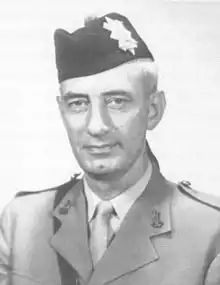Ronald E. J. Milne | |
|---|---|
 | |
| Background information | |
| Birth name | Ronald Edwin James Milne |
| Also known as | Ronnie Milne |
| Born | 11 April 1921 Surrey, England, United Kingdom |
| Died | 9 February 2014 (aged 92) Ottawa, Ontario, Canada |
| Genres | Big band, pop |
| Occupation(s) |
|
| Instrument(s) | Viola, trumpet |
| Formerly of | The Stargazers |
| Military career | |
| Allegiance | Canada |
| Service/ | Canadian Armed Forces |
| Rank | Captain |
(Capt.) Ronald Edwin James Milne (11 April, 1921 – 9 February, 2014) was a British-born singer and band director. He was also a composer and musical arranger who is known for his band arrangements and original compositions. He spent his formative years and the first years of his career in the United Kingdom, when he was widely known as Ronnie Milne. He subsequently auditioned to join the Canadian Army as a musician, was accepted in the rank of sergeant, and immigrated to Canada in 1953.
Biography
Early life
Milne was Born in Surrey, England, Milne came from a family of musicians, his father at one point playing with the Paris Opera left school in 1935 at the age of 14 and, along with his older brother Douglas, joined a juvenile band and toured Britain for several years. In 1939, he enlisted in the Welsh Guards Band, despite his Scottish heritage. In 1942 he won first prize for a jazz composition at the Professional "Jazz Jamboree" for his composition "October Mood", which he later confessed he rather disliked. Milne trained at the Royal College of Music and played viola for sometime in the London Symphony Orchestra
The Stargazers
Milne came to prominence in 1949 when he co-founded, in conjunction with Cliff Adams, Dick James, and others, the vocal group The Stargazers, which quickly came to enjoy commercial success.[1][2] The group appeared on such BBC Radio programmes as Workers' Playtime, and its fans included Queen Elizabeth II.[3]
Military career
Milne moved to live in Canada in 1953. There, he pursued for many years a military career, eventually becoming commissioned as a director of music and known as an arranger of music for band. His "Auprès de ma blonde" continues to be played by many wind ensembles.[4][5] On the side, he continued to arrange and perform popular music in a non-military context.
The high point of his military career was arguably the Tattoo[6] that took place in 1967 to mark the centenary of the creation of Canada. He was in charge of the music for this event, which concluded with a performance of his "Marche Vanier", a work dedicated to George Vanier, the Governor General who had died just months before.[7] Quoting from the Canadian Armed Forces Tattoo 1967 LP jacket, "Captain R. E. J. Milne, director of music of the Canadian Guards band, emigrated to Canada in 1953 after a distinguished musical career in his native Britain. He was Venturing into more popular forms of music after winning first prize in a jazz-writing competition, he arranged during the 1940s for Britain's big bands - Stanley Black, Geraldo, George Melachrino - and was staff arranger for the Ted Heath Orchestra. Captain Milne also played trumpet in big bands, formed and sang in a vocal group and worked extensively in radio and television in Britain."
After retiring from the Canadian Armed Forces with the rank of Captain he took up another career as a teacher of string instruments at Nepean High School in Ottawa. He died aged 92 in Ottawa, Ontario, on February 9, 2014.
References
- ↑ "The Stargazers Biography". Retrieved 10 May 2012.
- ↑ "The Stargazers". Retrieved 10 May 2012.
- ↑ "Concert Band Plays Tribute to Retired Captain". Archived from the original on 15 December 2013. Retrieved 10 December 2013.
- ↑ "Fanfare Reviews from March/April 1989". Retrieved 10 May 2012.
- ↑ "A Lakeshore Concert". Archived from the original on 6 March 2014. Retrieved 10 May 2012.
- ↑ "Military Will Stage Giant Roadshow". The Ottawa Citizen. 24 January 1966. Retrieved 10 May 2012.
- ↑ "Canadian Armed Forces Tattoo 1967". 1967. Retrieved 10 May 2012.